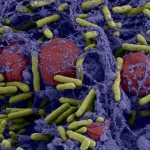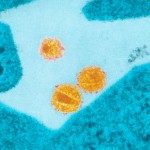Link to Pubmed [PMID] – 11867624
J. Biol. Chem. 2002 May;277(18):15677-89
Activation of CXCR4 by the CXC chemokine stromal cell-derived factor-1 (SDF-1) requires interaction of the amino-terminal domains of both molecules. We report that proteinases released from either mononucleated blood cells or polymorphonuclear neutrophils degranulated by inflammatory stimuli generate an SDF-1 fragment that is deleted from amino-terminal residues Lys(1)-Pro(2)-Val(3), as characterized by mass spectrometry analysis. The proteolyzed chemokine fails to induce agonistic functions and is unable to prevent the fusogenic capacity of CXCR4-tropic human immunodeficiency viruses. Furthermore, we observed that exposure of CXCR4-expressing cells to leukocyte proteinases results in the proteolysis of the extracellular amino-terminal domain of the receptor, as assessed by flow cytometry analysis and electrophoretic separation of immunoprecipitated CXCR4. Blockade of SDF-1 and CXCR4 proteolysis by the specific leukocyte elastase inhibitor, N-methoxysuccinyl-alanine-alanine-proline-valine-chloromethyl ketone, identified elastase as the major enzyme among leukocyte-secreted proteinases that accounts for inactivation of both SDF-1 and CXCR4. Indeed, purified leukocyte elastase generated in either SDF-1 or CXCR4 a pattern of cleavage indistinguishable from that observed with leukocyte-secreted proteinases. Our findings suggest that elastase-mediated proteolysis of SDF-1/CXCR4 is part of a mechanism regulating their biological functions in both homeostatic and pathologic processes.







